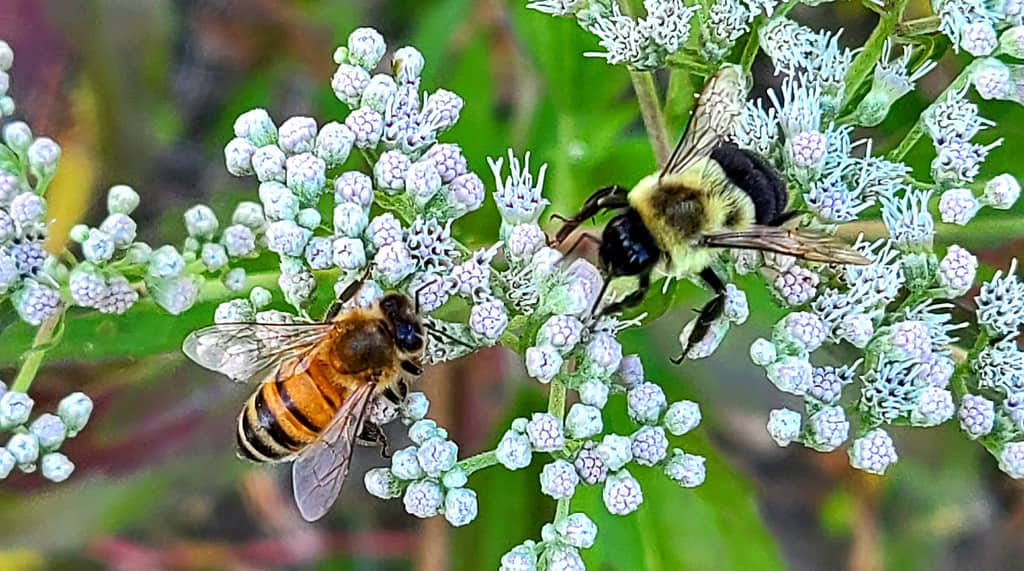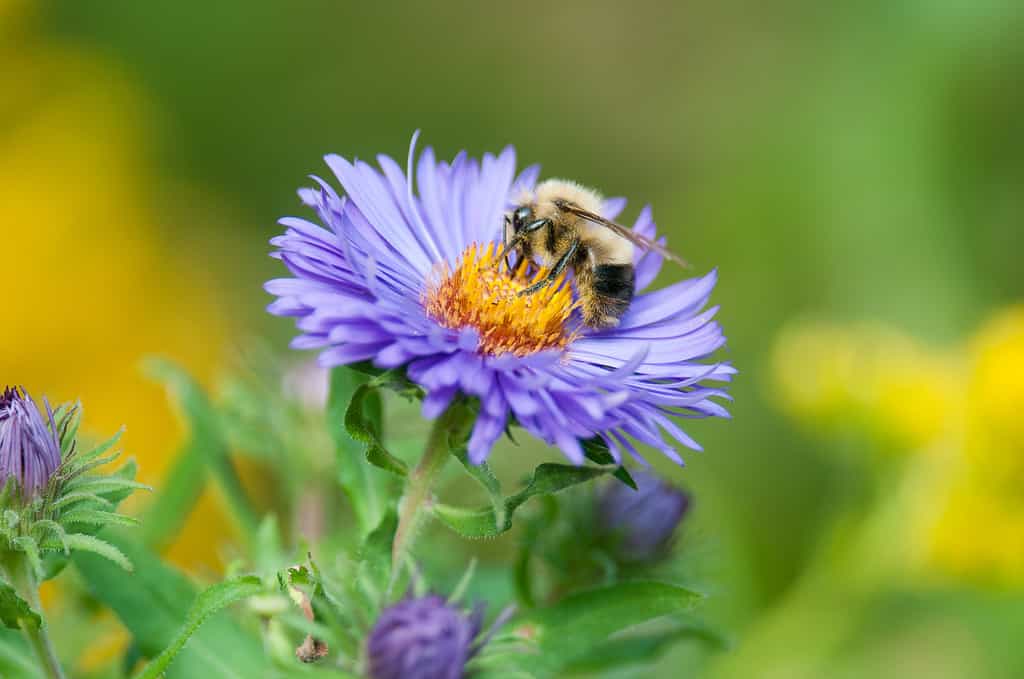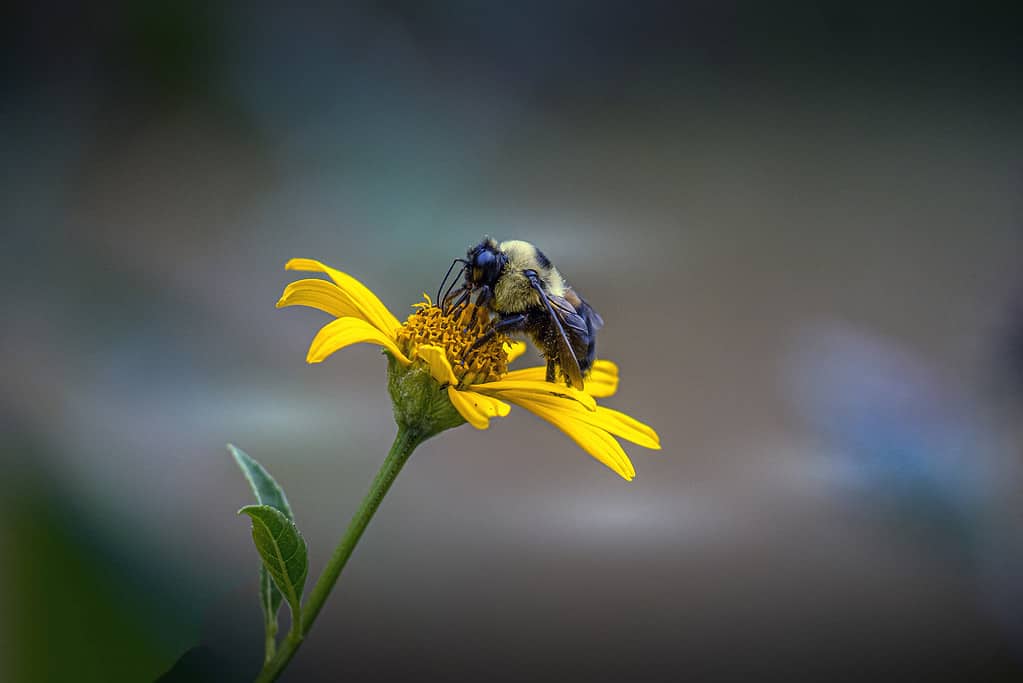Many people are afraid of bees, but their fear may be misplaced. The real concern is what we’ll do when bees are gone.
According to the International Union for Conservation of Nature (IUCN), there are approximately 20,000 different species of bees globally. Around 4,000 of these species are in the United States. Out of these global species, there are 156 bee species that are considered vulnerable. Another 20 species are endangered, and 11 are listed as critically endangered. Research from 2019 estimated that one in six bee species globally is regionally extinct and an additional 40% are vulnerable to extinction.
This may not seem critical until you take into account how important bees are to just about everything. Worldwide, wild and domestic honeybees perform about 80% of all pollination. Some plants like grains are primarily wind pollinated. However, critical food sources such as vegetables, fruits, and nuts are pollinated by bees. Greenpeace reports that 70 out of 100 of the world’s top food crops are pollinated by bees. These crops make up about 90% of the global population’s nutrition.
This means that if you take pollinators out of the equation, the human population is effectively critically handicapped when it comes to food production.
The Status of Bees in the United States

There are 49 species of bumble bees in the United States and each species differs in appearance.
©Sarah Bruce/iStock via Getty Images
Across the country, bees are on the decline. One study found that in 2008-2013, bee populations declined across 23% of the United States. The decrease in bees is so alarming that some now receive legal protections to prevent them from going extinct entirely.
These legal protections fall under the Endangered Species Act. In 1973, the United States passed the act to establish protections for wildlife and plants considered endangered or threatened. In 2016, the first bee species made their way onto the country’s endangered species list.
The Endangered Bees
The first bees granted protection under the act were seven Hawaiian species from the genus Hylaeus. The different species lack common names but are commonly referred to as yellow-faced bees. Hawaii is also home to 53 other bee species (including 20 endemic species), but the decline of these select species is concerning.
One year after the Hawaiian bees were added to the protected list, the continental United States’ first bee was added. Experts estimate that rusty-patched bumblebee numbers have declined by 87% over the past 20 years. It has disappeared from more than 80% of its original range in North America. In 2021, the Franklin bumble bee was also listed as protected under the Endangered Species Act.
These species are just the first to become endangered. Petitions have been filed to add more bees to the protection list, including American bumble bees, Gulf Coast solitary bees, variable cuckoo bumble bees, Mojave poppy bees, Southern Plains bumble bee, Western bumble bee, blue calaminthae bee, and Suckley’s cuckoo bumble bee.
Why Bees Are Endangered

The American bumble bee nests under grass or in the ground in fields and grasslands.
©Kyle Reynolds/iStock via Getty Images
A number of factors play into this severe decline in bee populations. Pesticides, diseases, parasites, climate change, air pollution, nutrition deficits, and habitat loss have all affected the bees. Research has found that bees in areas with high crop production have suffered disproportionate amounts. This is due to severe loss of habitat, as woodlands and grasslands are converted to farms. The native plant species are replaced with commodity crops and the accompanying pesticides and insecticides.
Insecticides and pesticides pose a huge threat to bees. Apiculturists at the University of California studied bee pollen and found it contained more than 150 different chemicals — something the researchers called a “pesticide cocktail.” These chemicals disorient, weaken, and paralyze bees. This causes them to die so fast that it’s impossible for the populations to reproduce fast enough to replace themselves.
One victim of these threats is the American bumble bee. A petition was filed in 2021 to add the American bumble bee to the Endangered Species Act list of protected species. According to the petition, this bee’s population has declined by 89% since 2000 and is at critical risk of extinction. Eight states (Idaho, New Hampshire, Maine, Oregon, North Dakota, Rhode Island, Vermont, and Wyoming) that were previously home to the American bumble bee have seen it disappear entirely. In New York, the species has declined by 99%, while the Midwest and Southeast have seen a 50% decline.
When Will Bees Go Extinct?

Growing global temperatures mean the bee may be extinct as soon as 2050.
©johnandersonphoto/iStock via Getty Images
With the rapid drops in bee numbers, it’s only a matter of time before bees start to go extinct entirely. Some researchers believe that bees will be extinct as soon as 2050. It’s impossible to say which species will disappear first, but there are several that are nearing extinction. For example, the variable cuckoo bumble bee was once in 28 states. Now, it has not actually been seen in any states since 1999. This means the population might already be at a critical tipping point — if it’s not extinct already.
Stopping this reduction in bee populations requires several different actions. First, dangerous pesticides need to be banned. If passed, the Saving America’s Pollinators Act introduced in 2019 would ban most uses of neonicotinoids (a group of systemic neurotoxic pesticides). This follows the lead of the E.U. and Canada.
Action also needs to be taken to prevent further climate change that affects natural weather patterns. Additionally, agricultural intensification and urbanization must be minimized to protect wild pollinator habitats. If bees are not protected, it could have catastrophic consequences, not just for bee species, but for the entire planet.
At-Risk Bees and Endangered Species Act Protection Status
| Bee Type | Scientific Name | Protection Status Under Endangered Species Act |
|---|---|---|
| Hawaiian Yellow Faced Bees | Hylaeus anthracinus, Hylaeus assimulans, Hylaeus facilis, Hylaeus hilaris, Hylaeus kuakea, Hylaeus longiceps, and Hylaeus mana | Added in 2016 |
| Rusty-Patched Bumble Bee | Bombus affinis | Added in 2017 |
| Franklin Bumble Bee | Bombus hyperboreus | Added in 2021 |
| Blue calaminthae bee | Osmia calaminthae | Petitioned in 2015 |
| Mojave Poppy Bee | Perdita meconis | Petitioned in 2018 |
| Gulf Coast Solitary Bee | Hesperapis oraria | Petitioned in 2019 |
| Suckley’s cuckoo bumble bee | Bombus suckelyi | Petitioned in 2020 |
| American Bumble Bee | Bombus pensylvanicus | Petitioned in 2021 |
| Variable Cuckoo Bumble Bee | Bombus variabilis | Petitioned in 2021 |
| Southern Plains Bumble Bee | Bombus fraternus | Petitioned in 2022 |
| Western bumble bee | Bombus occidentalis | Petitioned in 2023 |
The photo featured at the top of this post is © Matt Cuda/Shutterstock.com
Thank you for reading! Have some feedback for us? Contact the AZ Animals editorial team.






